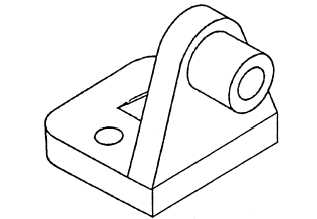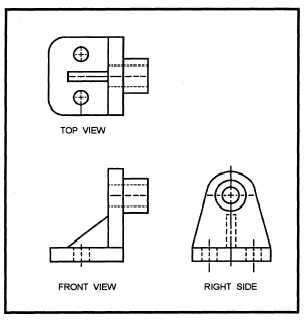While on the subject of dimensions, it should be noted that large objects are seldom drawn to their true size. Instead, the engineer or draftsman reduces the size of the object "to scale." For example, when drawing a 40-foot tower, the drawing may be prepared using a scale of 1/2"= 1'-0". In this case, the height of the tower, on paper, is 20 inches. The scale used to prepare working drawings is always noted on the drawing. It maybe a fractional scale, such as discussed here, or a graphic scale, such as the one shown in figure 3-40. In the Navy, both numerical and graphic scales are usually shown on construction drawings.
When you are using a drawing, the dimensions of an object should never be measured (scaled) directly from the drawing. These measurements are frequently inaccurate, since a change in atmospheric conditions causes drawing paper to shrink or expand. To ensure accuracy, always use the size and location dimensions shown on the drawing. If a needed dimension is not shown on the drawing, you should check the graphic scale, since it will always shrink or expand at the same rate as the drawing paper.
Notes
Drawing notes are used for different purposes and are either general or specific in nature. One example of how notes are used are the two notes shown in figure 3-40 that give the inside diameters of the holes. As you can see, these notes are used for size dimensioning. They are specific notes in that, by using a leader line, each note is referred to a specific hole or set of holes.
A general note is used to provide additional information that does not apply to any one particular part or feature of the drawing. For example, the drawing shown in figure 3-40 could contain a general note saying: "All holes shall be reamed using a tolerance of 1/64 inch."
Drawing Views
Look at the drawing shown in figure 3-41. This type of drawing is called a pictorial drawing. These drawings are frequently used to show how an object should appear after it is manufactured. Pictorial drawings are used as working drawings for a simple item, such as a metal washer. For a more complex object, as shown in figure 3-41, it becomes too difficult to provide a complete description in a pictorial drawing. In this case, it is common practice to prepare orthographic drawings to describe the object fully.

Figure 3-41. - Pictorial drawing of a steel part.

Figure 3-42. - Three-view orthographic drawing of the steel part shown in figure 3-41.
Assume you are holding the object shown in figure 3-41 in your hands. When you hold the object so you are looking directly at the top face of the object, the view you see is the top view. A drawing of that view is called an orthographic drawing.
Obviously, an orthographic drawing of only the top view of the object is insufficient to describe the entire object; therefore, additional orthographic drawings of one or more of the other faces of the object are necessary. The number of orthographic views needed to describe an object fully depends upon the complexity of the object. For example, a simple metal washer can be fully described using only one orthographic view; however, an extremely complex object may require as many as
Continue Reading